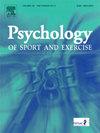Microsaccade behavior associated with inhibitory control in athletes in the antisaccade task
IF 3.1
2区 心理学
Q2 HOSPITALITY, LEISURE, SPORT & TOURISM
引用次数: 0
Abstract
The ability to achieve a state of readiness before upcoming tasks, known as a preparatory set, is critical for athletic performance. Here, we investigated these preparatory processes associated with inhibitory control using the anti-saccade paradigm, in which participants are instructed, prior to target appearance, either to automatically look at the target (pro-saccade) or to suppress this automatic response and intentionally look in the opposite direction (anti-saccade). We focused on microsaccadic eye movements that happen before saccade responses in either pro- or anti-saccade tasks, as these microsaccades reflect ongoing preparatory processes during saccade planning before execution. We hypothesized that athletes, compared to non-athletes, would demonstrate better preparation, given research generally indicating higher inhibitory control in athletes. Our findings showed that microsaccade rates decreased before target appearance, with lower rates observed during anti-saccade preparation compared to pro-saccade preparation. However, microsaccade rates and metrics did not differ significantly between athletes and non-athletes. Moreover, reduced microsaccade rates were associated with improved task performance in non-athletes, leading to higher accuracy and faster saccade reaction times (SRTs) in trials without microsaccades. For athletes, only SRTs were affected by microsaccade occurrence. Moreover, the modulation of microsaccadic inhibition on accuracy was more pronounced in non-athletes compared to athletes. In conclusion, while microsaccade responses were modulated by task preparation, differences between athletes and non-athletes were non-significant. These findings, for the first time, highlight the potential of using microsaccades as an online objective index to study preparatory sets in sports science research.
运动员在反扫视任务中的微扫视行为与抑制控制相关。
在即将到来的任务之前达到准备状态的能力,也就是所谓的准备状态,对运动员的表现至关重要。在这里,我们使用反扫视范式研究了这些与抑制控制相关的准备过程,在该范式中,参与者被指示在目标出现之前,要么自动地看向目标(前扫视),要么抑制这种自动反应并有意地看向相反的方向(反扫视)。我们关注的是在反应扫视前或反扫视任务中发生的微扫视眼动,因为这些微扫视反映了在执行前扫视计划期间正在进行的准备过程。我们假设,与非运动员相比,运动员会表现出更好的准备,因为研究普遍表明运动员有更高的抑制控制。我们的研究结果表明,在目标出现之前,微扫视率下降,与扫视前准备相比,在反扫视准备期间观察到的微扫视率较低。然而,运动员和非运动员之间的微扫视率和指标没有显著差异。此外,在非运动员中,微扫视率的降低与任务表现的改善有关,在没有微扫视的试验中,导致更高的准确性和更快的扫视反应时间(srt)。对于运动员来说,只有srt受到微眼跳发生的影响。此外,与运动员相比,微跳抑制对准确性的调节在非运动员中更为明显,尽管这种影响仅显着。综上所述,运动员和非运动员的微扫视反应受到任务准备的调节,但差异不显著。这些发现首次强调了使用微跳作为在线客观指标来研究体育科学研究中的准备集的潜力。
本文章由计算机程序翻译,如有差异,请以英文原文为准。
求助全文
约1分钟内获得全文
求助全文
来源期刊
CiteScore
6.40
自引率
5.90%
发文量
172
审稿时长
69 days
期刊介绍:
Psychology of Sport and Exercise is an international forum for scholarly reports in the psychology of sport and exercise, broadly defined. The journal is open to the use of diverse methodological approaches. Manuscripts that will be considered for publication will present results from high quality empirical research, systematic reviews, meta-analyses, commentaries concerning already published PSE papers or topics of general interest for PSE readers, protocol papers for trials, and reports of professional practice (which will need to demonstrate academic rigour and go beyond mere description). The CONSORT guidelines consort-statement need to be followed for protocol papers for trials; authors should present a flow diagramme and attach with their cover letter the CONSORT checklist. For meta-analysis, the PRISMA prisma-statement guidelines should be followed; authors should present a flow diagramme and attach with their cover letter the PRISMA checklist. For systematic reviews it is recommended that the PRISMA guidelines are followed, although it is not compulsory. Authors interested in submitting replications of published studies need to contact the Editors-in-Chief before they start their replication. We are not interested in manuscripts that aim to test the psychometric properties of an existing scale from English to another language, unless new validation methods are used which address previously unanswered research questions.

 求助内容:
求助内容: 应助结果提醒方式:
应助结果提醒方式:


